 |
|
 26-Nov-2020, 2:52 PM
26-Nov-2020, 2:52 PM
|
#81
|
|
Senior Member
Join Date: Jan 2010
Location: Dallas, TX
Posts: 173
|
Rabbit73, looks like you have a good collection of equipment for portable testing.
Having a near field view over open water helps with signal reception.
Quote:
Originally Posted by rabbit73

]... how is it possible for you to make a valid comparison of the performance of the two systems?...
|
That depends on the accuracy one may be looking for and the test environment. If looking for accuracy in the one dB or less range, it may be very difficult.
Quote:
|
... Have the two antennas on a sliding carriage that moves each antenna into the same location, or what? ...
|
That could be useful. Depending on the variability of the received signals and the length of time the test systems are evaluated.
Quote:
|
... how can you possibly get a comparison like you would on a lab grade antenna range? ...
|
Probably not practical for most.
As you know, a lab grade antenna range is implemented in such a way to minimize all reflections that could be received in the main beam or sidelobes of the antenna under evaluation.
Quote:
|
... On a range, you would use a constant strength test signal and place each antenna, in turn, in the same location...
|
Test ranges are usually setup to evaluate antennas loaded by a specified impedance. They do not usually evaluate antenna preamp combinations.
Quote:
|
...The closest I got to the ideal was to switch the two antenna locations, but I really wanted to be able to slide them sideways...
|
If the signal variability is not too great, and the accuracy requirements are not too stringent, in most cases that probably works OK.
General comment:
All measurements have limits in accuracy. For most TV reception purposes, the measurements taken with less than optimum conditions may be satisfactory.
In comparative testing, if there variables that one cannot control. Some form of averaging to wash out the variability can be helpful.
In the case of systems receiving signals that vary with time, then time averaging can reduce the errors. If long enough time and enough samples are averaged for each system under test, then errors in measurement can be reduced.
===========================
Quote:
Originally Posted by eclipsme

...would splitting 1 feed to the 2 systems work? Then reverse the feeds to compensate for output differences of the splitter and average the results?...
|
If accuracy requirements are not too stringent, then what you seem to be suggesting can help with comparison of two preamps or two receiving systems.
However, the preamps may behave slightly different when connected to an actual receiving antenna with different transmission line and no splitter. In many case, this difference could be small enough to not matter to the individual performing the test.
.
|

|

|
 26-Nov-2020, 3:45 PM
26-Nov-2020, 3:45 PM
|
#82
|
|
Retired A/V Tech
Join Date: Aug 2012
Location: S.E. VA
Posts: 2,750
|
Quote:
Originally Posted by tripelo

Rabbit73, looks like you have a good collection of equipment for portable testing.
|
Thank you for your comments.
My wife supported my experiments, so I was able to collect the equipment I needed to solve reception problems.
Quote:
|
Having a near field view over open water helps with signal reception.
|
Yes, the signals were quite constant, except when a boat went by in the signal path. 
Quote:
|
That depends on the accuracy one may be looking for and the test environment. If looking for accuracy in the one dB or less range, it may be very difficult.
|
Yeah, I never felt I needed an attenuator with 0.1 dB steps.
Quote:
|
As you know, a lab grade antenna range is implemented in such a way to minimize all reflections that could be received in the main beam or sidelobes of the antenna under evaluation.
|
Yes, reflections are an ever present problem.
Kent Britain, WA5VJB, creator of the Cheap Yagi, would place the antennas at ground level to minimize ground reflections during antenna shootouts. I tried that with indoor antenna tests. The results were consistent with results at 3 ft above the floor, but the signals were about 20 dB weaker on the floor (concrete slab covered with carpet).
http://www.wa5vjb.com/references/Ant...0Notes-keb.pdf
WA5VJB Antenna Measuring Notes, Extract
Kent Britain WA5VJB (Written for Scatterpoint issue 1-2000 updated Sept 2006)
Quote:
Since 1987 I have set up my portable antenna range at 26 Conferences measuring well over 1500 antennas, mainly in the 0.9 to 24 GHz range. G4DDK has asked me to list some of my observations.
Open Area:
30 to 40 Meters is nice, but I have often set up in more confined areas of 10 to 20 Meters. But I try to avoid areas near walls that might cause reflections. Given a choice, I set up on grass (easier on my feet) but parking lots can also be used. The whole idea is to find an area where you have a consistent signal about the same size as the capture area of the antenna. i.e. a bit bigger than the biggest antenna you plan to test. Our greatest source of error is having the signal level on one edge of the dish stronger than on the other edge of the dish.
I gave up on elevated ranges a few years ago. I almost always set up with the source antenna (Usually a horn) sitting right on the ground. Thus the antenna and its reflected image are virtually the same point. Sometimes the horn is sitting on a sheet of metal, sometimes it's sitting on a sheet of absorber. Sheets of the Carbon loaded foam work well if you don't have an Eccosorb. Also the sheet of magnetic material that hold advertising to your fridge work well as Iron loaded absorber. The sheet metal gives me a little more signal; the absorber usually gives me a cleaner test area. Although there is no hard fast rule here, I just use what ever works best. If there is a nice consistent signal area, we start measuring antennas!
|
END OF EXTRACT
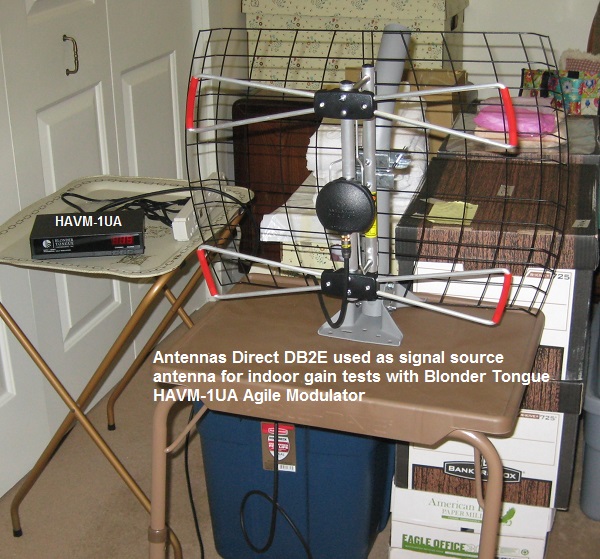
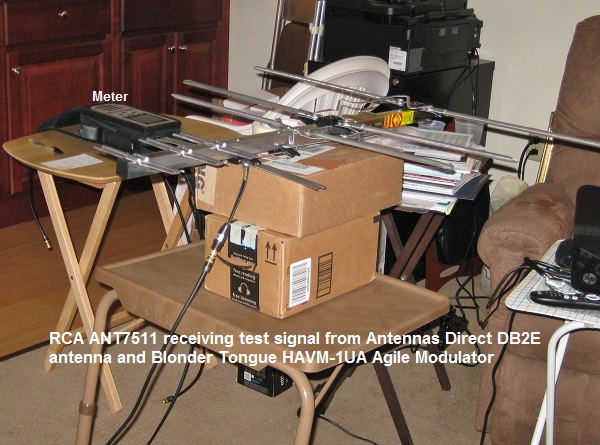
Quote:
|
If the signal variability is not too great, and the accuracy requirements are not too stringent, in most cases that probably works OK.
|
My conclusion, also.
Quote:
In comparative testing, if there variables that one cannot control. Some form of averaging to wash out the variability can be helpful.
In the case of systems receiving signals that vary with time, then time averaging can reduce the errors. If long enough time and enough samples are averaged for each system under test, then errors in measurement can be reduced.
|
That sounds like the best approach for your comparisons, since you are not just comparing antenna and preamp combinations, but antenna, preamp, and antenna location combinations.
_____________________________
Happy Thanksgiving!
Hope you are staying safe.
Best regards,
rabbit73
Last edited by rabbit73; 27-Nov-2020 at 4:23 AM.
|

|

|
 27-Nov-2020, 2:14 PM
27-Nov-2020, 2:14 PM
|
#83
|
|
Senior Member
Join Date: Jan 2010
Location: Dallas, TX
Posts: 173
|
Quote:
Originally Posted by rabbit73

..My wife supported my experiments, so I was able to collect the equipment I needed to solve reception problems.
|
Very good to have cooperation from spouse.
Thanks for the .pdf, interesting read.
Wonder how you use the BT double sideband Modulator?
Do you inject a tone to provide a pair of CW signals, or add a DTV baseband. or something else?
Quote:
...Happy Thanksgiving!
Hope you are staying safe...
|
Thanks, happy holidays to you.
.
|

|

|
 27-Nov-2020, 6:03 PM
27-Nov-2020, 6:03 PM
|
#84
|
|
Retired A/V Tech
Join Date: Aug 2012
Location: S.E. VA
Posts: 2,750
|
Quote:
Originally Posted by tripelo

Wonder how you use the BT double sideband Modulator?
Do you inject a tone to provide a pair of CW signals, or add a DTV baseband. or something else?
|

My use is very simple. I don't have a UHF signal generator, so I use the NTSC video carrier of the modulator as a constant strength test signal. All I have to do is select an output channel on the Agile Modulator and tune my signal level meter or SDR to that frequency. It isn't necessary to modulate the carrier, the video carrier exists without video or audio input.
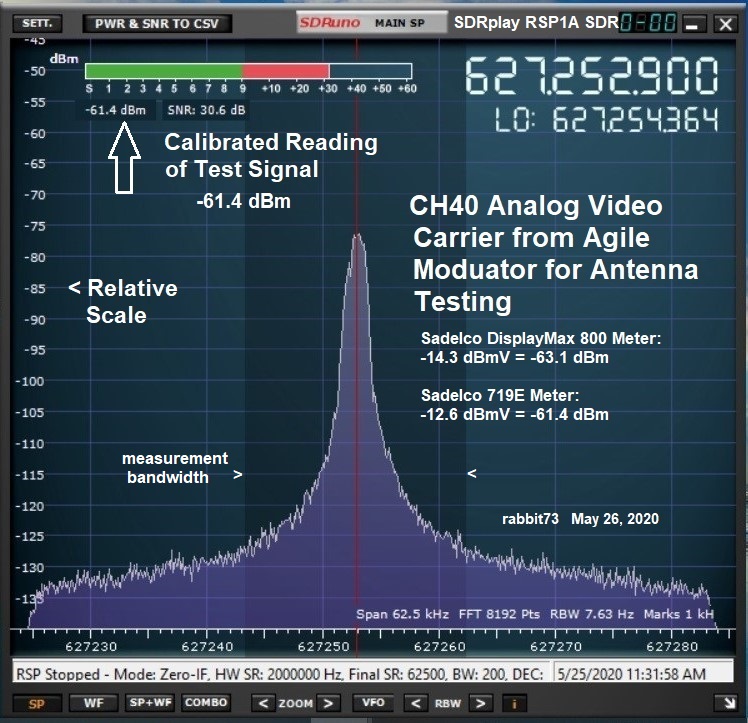
For VHF, I use a more sophisticated (and expensive) source; I generate an ATSC 1.0 carrier with my Thor Petit Modulator.
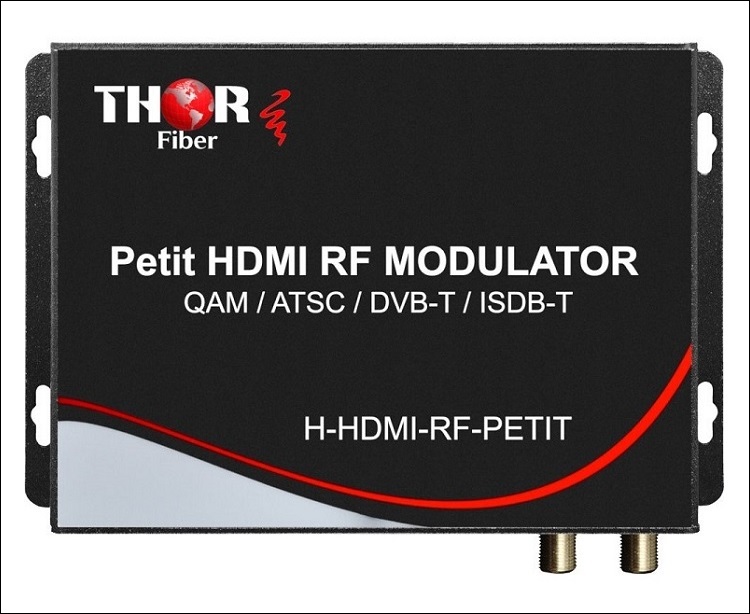

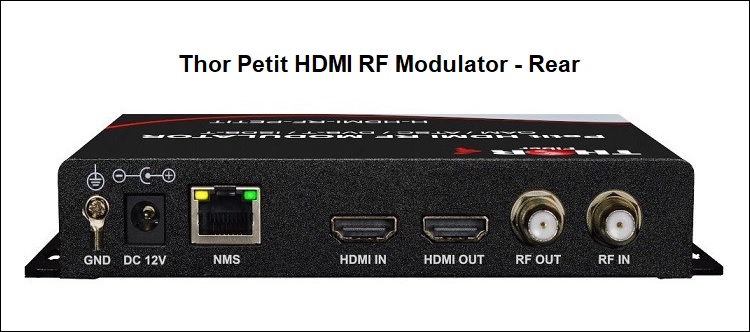
Testing the Thor Petit HDMI RF MODULATOR
https://www.avsforum.com/threads/tes...lator.3095882/
Last edited by rabbit73; 27-Nov-2020 at 11:21 PM.
|

|

|
 27-Nov-2020, 6:50 PM
27-Nov-2020, 6:50 PM
|
#85
|
|
Senior Member
Join Date: Jan 2010
Location: Dallas, TX
Posts: 173
|
Quote:
Originally Posted by rabbit73

...
My use is very simple. I don't have a UHF signal generator, so I use the NTSC video carrier ...exists without video or audio input.
|
OK, yes.
Not that it would be a serious problem for most antenna testing;
Being a double sideband modulator, doesn't the NTSC video carrier show up twice in the spectrum?
Quote:
|
For VHF, ... generate an ATSC 1.0 carrier with my Thor Petit Modulator.
|
Doesn't the Thor Petit also cover UHF?
.
|

|

|
 27-Nov-2020, 8:26 PM
27-Nov-2020, 8:26 PM
|
#86
|
|
Retired A/V Tech
Join Date: Aug 2012
Location: S.E. VA
Posts: 2,750
|
Quote:
Originally Posted by tripelo

Being a double sideband modulator, doesn't the NTSC video carrier show up twice in the spectrum?
|
Yes, it does; that is why you can only use every other channel when adding a channel. But, all I have to do is tune my SLM or SDR to the video carrier frequency of the channel transmitted by the modulator.

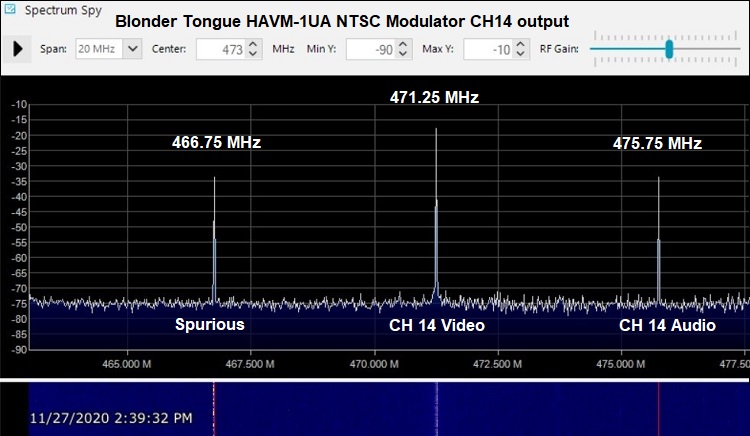
Quote:
|
Doesn't the Thor Petit also cover UHF?
|
Yes, it does, but I didn't have it at first because it was so expensive. I waited until it went on sale, which it is also now again.
The video carrier is more precise; the ATSC signal is much wider and not always flat. So, where do you measure the ATSC Carrier when it isn't flat? My SLM takes an average of many readings when it scans the whole ATSC channel, but can measure the NTSC video carrier more exactly. With the SDR, I can select the measurement frequency at any place on the ATSC channel.
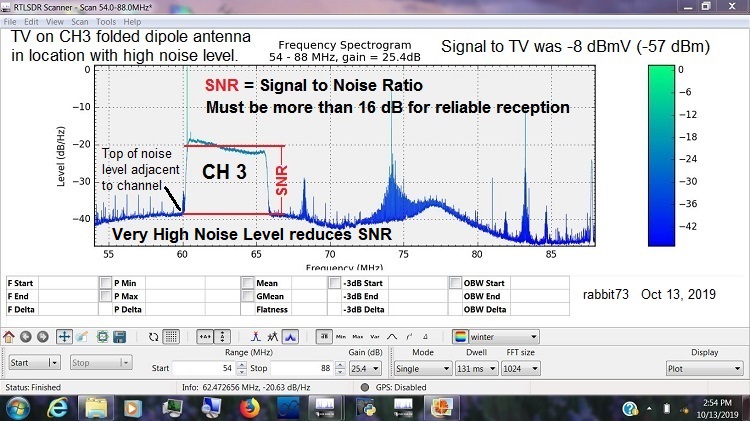
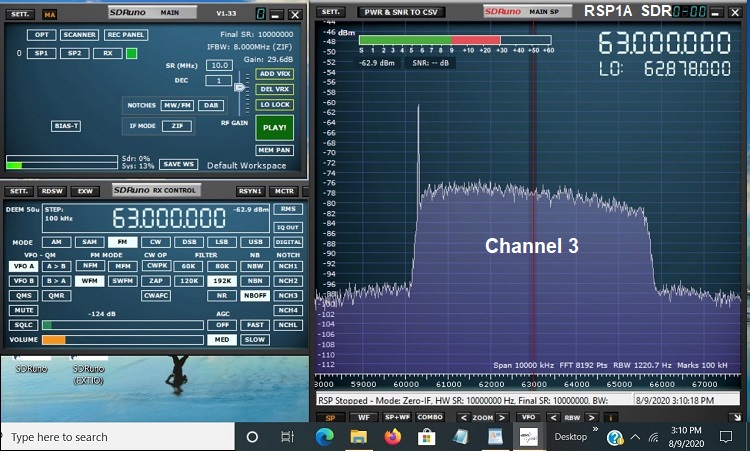
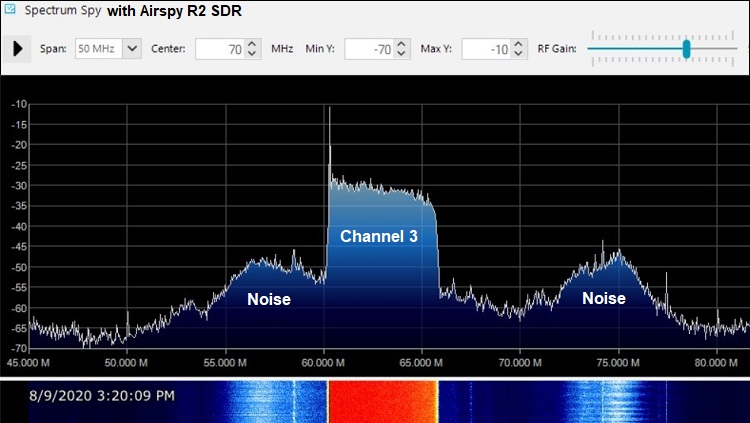
Last edited by rabbit73; 27-Nov-2020 at 10:32 PM.
|

|

|
 27-Nov-2020, 10:56 PM
27-Nov-2020, 10:56 PM
|
#87
|
|
Senior Member
Join Date: Jan 2010
Location: Dallas, TX
Posts: 173
|
Thanks for the images.
Looks like displays from three different STL-SDR units,
that is if the RTLSDR Scanner is running on one of the lower cost devices?
When comparing the SDRplay and the Airspy,
noticed the noise spectrum on the lower frequency side of Channel 3 is different for each.
Specifically, the noise is increasing near lower edge of Ch3 for the SDRplay,
for the Airspy decreases a bit near lower edge of Ch 3.
Wonder if that reoccurs, repeatable?
.
|

|

|
 27-Nov-2020, 11:52 PM
27-Nov-2020, 11:52 PM
|
#88
|
|
Retired A/V Tech
Join Date: Aug 2012
Location: S.E. VA
Posts: 2,750
|
Quote:
Originally Posted by tripelo

Looks like displays from three different STL-SDR units,
that is if the RTLSDR Scanner is running on one of the lower cost devices?
|
That is correct. The last three images were:
1. RTL-SDR.COM V3 dongle with free open-source Scanner software from GitHub
2. SDRplay RSP1A SDR with SDRuno software
3. Airspy R2 SDR with Spectrum Spy software that is included with the SDR# (SDRsharp) software download
Quote:
When comparing the SDRplay and the Airspy,
noticed the noise spectrum on the lower frequency side of Channel 3 is different for each.
Specifically, the noise is increasing near lower edge of Ch3 for the SDRplay,
for the Airspy decreases a bit near lower edge of Ch 3.
|
Yes; three factors account for that:
1. The noise floor is not constant on VHF, especially VHF-Low; the scans were done at different times
2. The RSP1A with the SDRuno software is limited to a useful bandwidth of about 8 MHz; each side falls off pretty fast. The Airspy R2 with the Spectrum Spy software has an extremely wide bandwidth for a scan only limited to the full bandwidth of the R2.
3. The bandwidth of the antenna

Last edited by rabbit73; 28-Nov-2020 at 12:36 AM.
|

|

|
 28-Nov-2020, 12:55 AM
28-Nov-2020, 12:55 AM
|
#89
|
|
Senior Member
Join Date: Jan 2010
Location: Dallas, TX
Posts: 173
|
Quote:
Originally Posted by rabbit73

...The RSP1A with the SDRuno software is limited to a useful bandwidth of about 8 MHz; each side falls off pretty fast.
|
OK, understood.
Quote:
|
..The Airspy R2 with the Spectrum Spy software has an extremely wide bandwidth for a scan only limited to the full bandwidth of the R2...
|
OK, not understood 
Can the Airspy not scan & display a narrow 8-10 MHz region like the RSP1?
When the RSP1 scans from say 45 MHz to 80 MHz,
does the spectrum look like the Airspy R2 spectrum at the lower part of Channe 3?
.
|

|

|
 28-Nov-2020, 2:26 AM
28-Nov-2020, 2:26 AM
|
#90
|
|
Retired A/V Tech
Join Date: Aug 2012
Location: S.E. VA
Posts: 2,750
|
Quote:
Originally Posted by tripelo

Can the Airspy not scan & display a narrow 8-10 MHz region like the RSP1?
|
The Airspy R2 can scan 8 MHz with the SDR# software, similar to what the RSP1A does with the SDRuno software. It is important to set the gain at the correct level to obtain the proper presentation of the SNR; too much or too little will show the wrong SNR. Increase gain until the adjacent noise floor just starts to rise and the signal no longer increases in strength. That point should show MAX SNR.
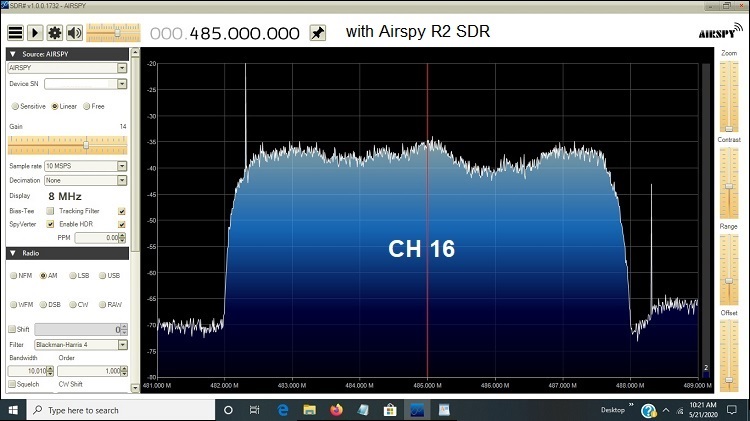
R2 and Spectrum Spy at 10 MHz width:
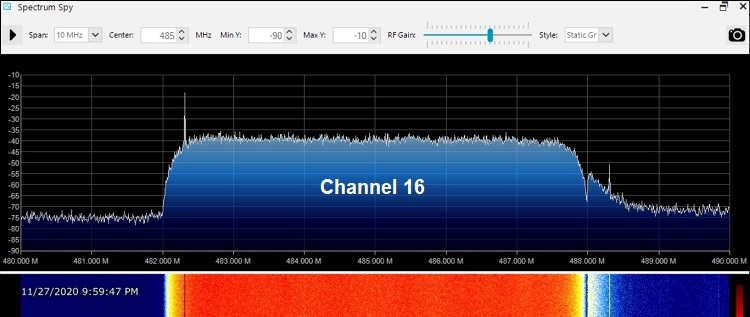
Quote:
When the RSP1 scans from say 45 MHz to 80 MHz,
does the spectrum look like the Airspy R2 spectrum at the lower part of Channe 3?
|
As I said earlier, the RSP1A can only scan 8-10 MHz with the SDRuno software. It can only do a wider scan using the RSP Spectrum Analyser software (the software that you said has too many spurs). Some of the "spurs" are actually pilot carriers of weak ATSC signals. Some are noise spikes. Some are clock spurs that can be removed before a scan.
50 MHz width with RSP1A and RSP Spectrum Analyser:
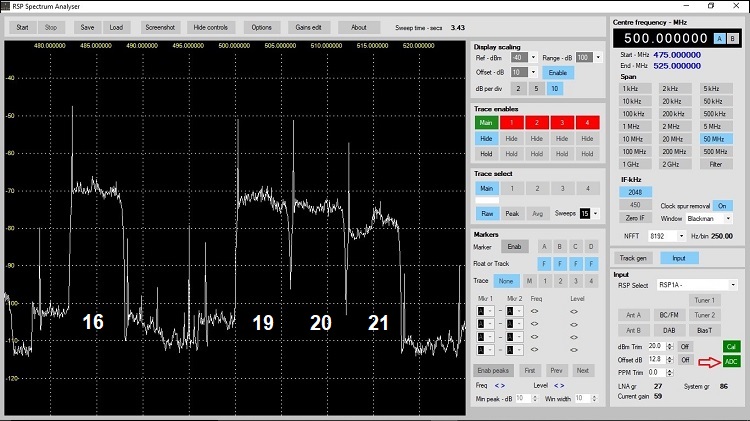
I don't actually have an RF channel 3 in this area, or any 2-6 channel. That is why I bought the Thor modulator to simulate an RF 3 ATSC channel. I have been studying the affect that a high noise level has on the reception of VHF-Low channels.
I first became interested in that project while trying to help a Canadian receive RF 2 and 4. I thought a CH3 folded dipole had a chance of receiving both. He was having no luck using an FM folded dipole of twinlead with 30 gauge conductors. I encouraged him to make a CH3 FD with larger diameter conductors, but he seemed unwilling to do it. I suspected that he had sufficient signal strength, but a high noise level. He was able to receive 9 OK.
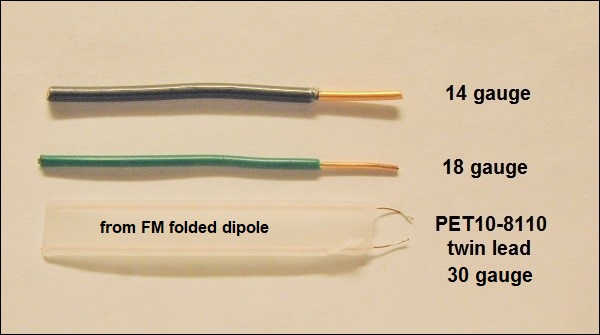


I have two CH3 folded dipoles. I have one connected to the output of the Thor modulator. The other is connected to my SDR or a TV. It picks up the CH3 ATSC signal from the Thor modulator as if it were an OTA signal AND the ambient noise. This tells me how much stronger a VHF-Low signal needs to be for a sufficient SNR above the ambient noise.
If you want a specific test done, I could set it up over the weekend. I don't keep the CH3 folded dipoles set up in my room. I would need to know exactly what test you want me to do.
I could try to do 45 to 80 with all three SDRs, but it would require both CH3 folded dipoles to pick up the ambient noise.
Last edited by rabbit73; 28-Nov-2020 at 3:04 PM.
|

|

|
 28-Nov-2020, 2:48 PM
28-Nov-2020, 2:48 PM
|
#91
|
|
Senior Member
Join Date: Jan 2010
Location: Dallas, TX
Posts: 173
|
Quote:
Originally Posted by rabbit73

...RSP Spectrum Analyser software (the software that you said has too many spurs). Some of the "spurs" are actually pilot carriers of weak ATSC signals. Some are noise spikes. Some are clock spurs that can be removed before a scan...
|
Yes, OK.
Quote:
|
..I have two CH3 folded dipoles. ...This tells me how much stronger a VHF-Low signal needs to be for a sufficient SNR above the ambient noise....
|
Understood.
Quote:
|
...If you want a specific test done...
|
Thanks.
Appreciate the offer, but not necessary.
Your several images in this thread provide a fairly good idea of what can be expected from the RTL-SDR devices.
-----------------------
One of the specific tests planned in KY:
To determine if the 3rd order IMD from a broadcast station can be seen on one of these devices. The station IMD3 is strongest very near the edges 6 MHz spread. However, those edges are also where the SDR-RTL internal IMD may be highest. Therefore, it may be difficult to see low level station IMD with such devices.
Another requirement for such an observation is for the broadcast station to be fairly well isolated from any other stations and have a high S/N ratio (in some case 50 dB or more). This condition may not be met in populated areas (cities, etc). There is a PBS station in rural KY that meets such criteria.
------------------------
Appreciate the patience, tests, and and images you have displayed in this thread and others.
.
|

|

|
 Posting Rules
Posting Rules
|
You may not post new threads
You may not post replies
You may not post attachments
You may not edit your posts
HTML code is Off
|
|
|
|
|

